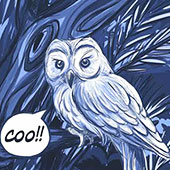To get started into comic book or graphic novel, there are certain aspects, which are essential to be aware about. These topics act as a backbone to which sequential art depend upon.
• Writing
Words have been telling stories for many centuries and is still being practiced without any imagery involved. But in the field of sequential art, such as comics, it also has a vital role to play, with the interlacing of images. The relationship of words and images is such that of mind and heart, that is its crucial to have a perfect balance between the two. Some instances can also be communicated with the images, where as in other times it can’t be conveyed without texts.
So the writing and illustrations should work so well that the reader should find it effortless to jump from one panel to the other.

(Fig.1) Chacha Chaudary Comics, By Pran Kumar Sharma (1969).

(Fig.2) Comic Page from Comics and Sequential Art, by Will Eisner.
• Image
Creating pictures to fill the frames and bring life to the story/ idea constitutes this section. Comics communicate through the placement of words and images. Here, the real artistic skills come to play where the artist actually draws out their idea.
Irrelevant of what kind of style is used, it’s a crucial process to know which drawing will suit best to convey the story. Remembering that too much imagery can also be a disadvantage, telling of the story should have a limited number of drawings for better pacing.

(Fig.3) Page from Scott Pilgrim- Volume 1, By Bryan Lee O’Malley.
Drawing the images almost always deals with expression of characters, so posing and placement of characters should also be effectively scrutinized for the reader to understand the message as clear as possible, and not wasting any time.
Below, for example, the images are places in a way where words are least required and the story/situation is conveyed:

(Fig.4) Image, Comics and Sequential Art, by Will Eisner.
• Timing
The decision making of which moment or frame should be included, is a crucial process, and is of great priority. This procedure is basically a planning stage where a story’s events are broken down to more parts to understand which moments are required and which can be left out. The key is to make the whole story compact and up to the exact frames only. This enhances the quality of the comic, as not all moments are relevant.
Every frame of the illustration/image conveys a moment in time of the story. Thus correct paneling is the fundamental to this art. These decisions are finalized mainly in the planning stage to understand the rhythm of the storytelling.

(Fig.5) Example from Comics and Sequential Art, By Will Eisner.
From the above example, we can understand more clearly understand the power of good timing in a comic. The first shows a simple action whose result is immediate… in seconds, whereas the second set shows the same but the result frame is only extended to enhance emotion.

(Fig.6) Comic page, by Will Eisner.
• Framing
Sequential art tells a story through multiple panels. Every comic book/ strip has some kind of narrative flow where it captures the events in framed or unframed sequences. This is quite similar to choosing the appropriate camera angle in film or photography.
Framing of the panels is very vital, as the artist needs to guide the reader to the exact required point of interest. Since we should not want the reader to wonder about, the artist should arrange the frames eloquently enough to take control for the reader.

(Fig.7) Image, Comics and Sequential Art, Will Eisner.

(Fig.8) The bus, By Paul Kirchner (1987).

